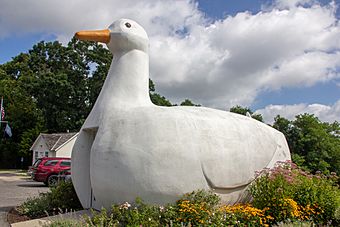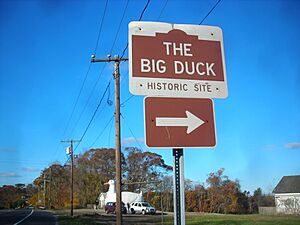Big Duck facts for kids
Quick facts for kids |
|
|
The Big Duck
|
|

The Big Duck was constructed in the 1930s to help its owner's duck farming business.
|
|
| Location | Flanders, New York, Suffolk County, New York, USA |
|---|---|
| Built | 1930-31 |
| Architectural style | Novelty architecture |
| Website | http://www.bigduck.org/ |
| NRHP reference No. | 97000164 |
| Added to NRHP | April 28, 1997 |
The Big Duck is a unique building shaped like a giant duck! It's located in Flanders, New York, on Long Island. Built in 1931, it was originally a shop for a duck farmer named Martin Maurer. He sold ducks and duck eggs there. This famous building was added to the National Register of Historic Places in 1997. It's also a main part of the Big Duck Ranch, which joined the National Register in 2008.
Contents
About The Big Duck
The Big Duck is a really big building shaped like a duck. It is about 18 feet (5.5 meters) wide and 30 feet (9.1 meters) long. The top of its head reaches 20 feet (6.1 meters) high.
What The Big Duck Looks Like
The duck's eyes are made from old Ford Model T car tail lights. Inside, the shop area is about 11 feet (3.4 meters) by 15 feet (4.6 meters). The building is made with a wood frame, wire mesh, and concrete. It was designed to look like a Pekin duck. This was perfect for a store selling poultry.
The Big Duck's History
The Big Duck was built in 1930 and 1931. Its owner, Martin Maurer, chose a busy spot on Main Street in Riverhead. This was a great place on Long Island, New York, to attract customers.
Building and Early Fame
Builders Smith and Yeager finished the concrete work on The Big Duck. It was even featured in Atlas Cement's calendar in 1931. The duck also appeared in Popular Mechanics magazine.
Moving to Flanders
In 1937, Martin Maurer moved the building. It traveled four miles (6 km) southeast to Flanders. Here, it was close to Maurer's new duck farm. This whole area, including Flanders and Riverhead, was famous for duck farming. By 1939, Suffolk County had about 90 duck farms!
Later Years and Return Home
The Big Duck's unique shape and good location helped it get lots of attention. It stayed open until 1984. In 1988, Suffolk County took over The Big Duck. They moved it to Route 24. This spot was near Sears-Bellows Pond County Park.
The building became a gift shop. It was run by the Friends for Long Island Heritage. In 2004, there was talk of moving the duck again. But on October 6, 2007, it was returned to its Flanders home. Suffolk County still owns and cares for the inside of the duck. Southampton Town takes care of the outside. The original 27-acre (11-hectare) duck farm was bought by the town in 2006. Today, The Big Duck is still a gift shop selling fun souvenirs.
Fun Facts About The Big Duck
- Famous model Christie Brinkley recorded a welcome message for visitors.
- The Big Duck was in a sketch on the children's TV show Between the Lions. The sketch was called "Moby Duck," a funny version of the story Moby Dick.
- Every Christmas since 1988, The Big Duck gets decorated with lights. A giant wreath hangs around its neck. Local people have a special ceremony each year to turn on the lights.
The Big Duck's Impact
Buildings like The Big Duck are called novelty architecture. This means they are built in a fun, unusual shape. In architecture, the term "duck" is used for buildings shaped like the product they sell. For example, a building shaped like a hot dog would be a "duck."
Architectural Influence
The Long Island newspaper Newsday said that The Big Duck has influenced architecture around the world. Any building shaped like its product is now called a "duck." At first, some people didn't like The Big Duck's style. But architects Robert Venturi and Denise Scott Brown defended it. They said it was important because it combined both function and symbolism. They even helped make the term "duck" popular for this type of building.
Long Island Landmark
On November 13, 2006, radio station WBLI named The Big Duck as one of the 7 wonders of Long Island. It was ranked first!




